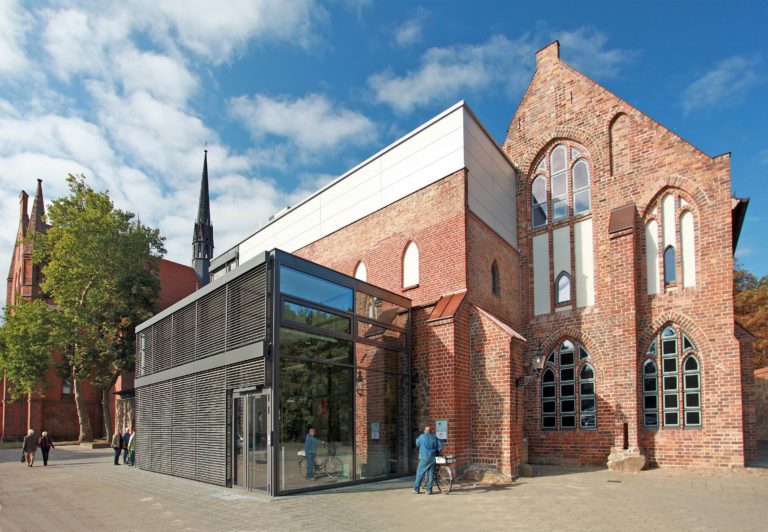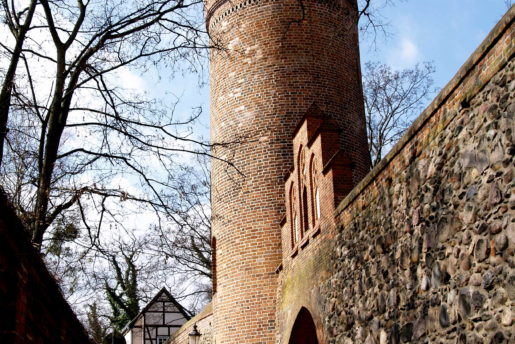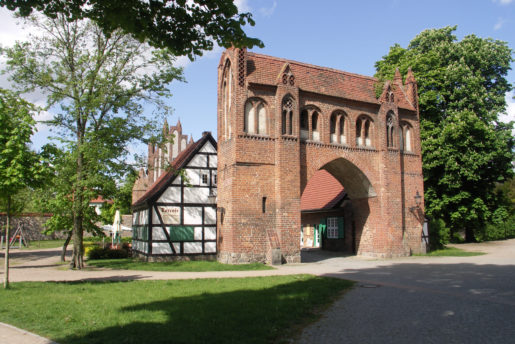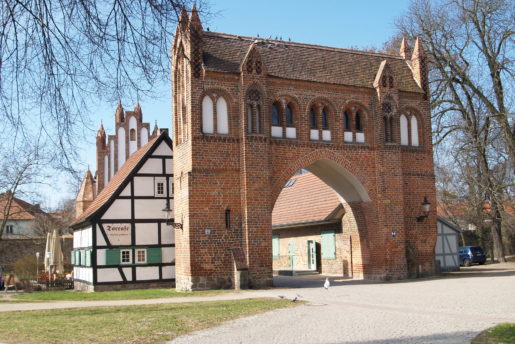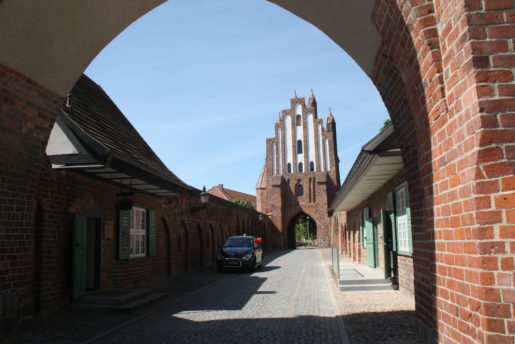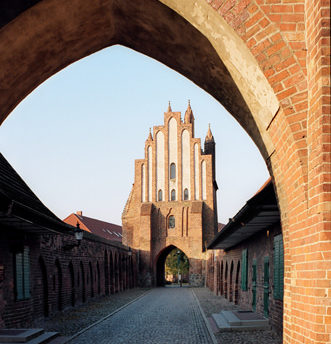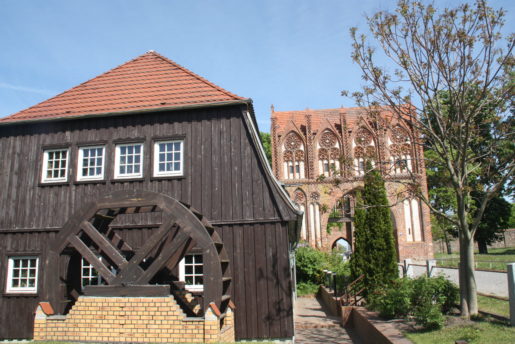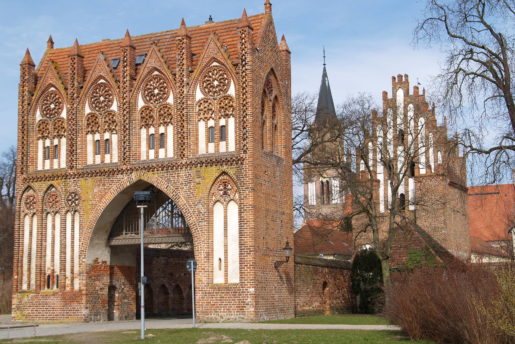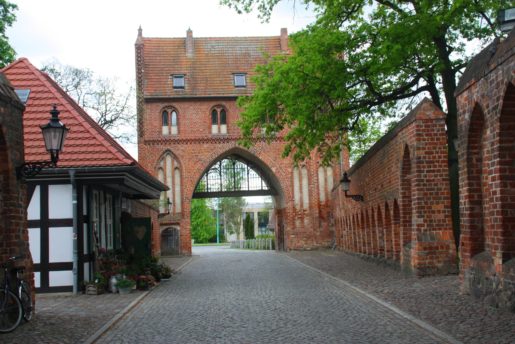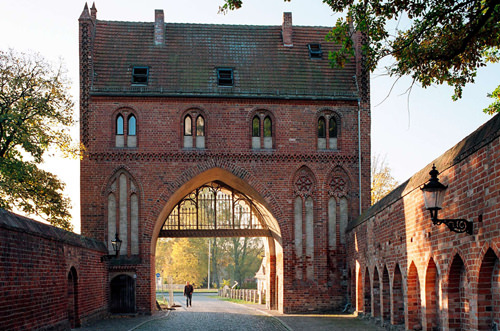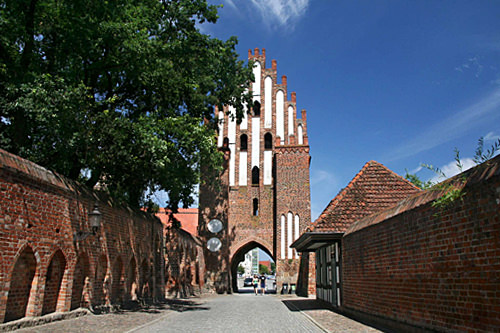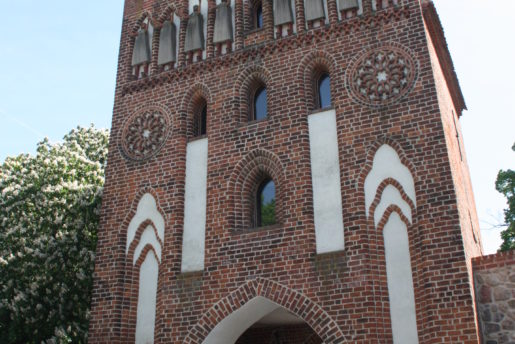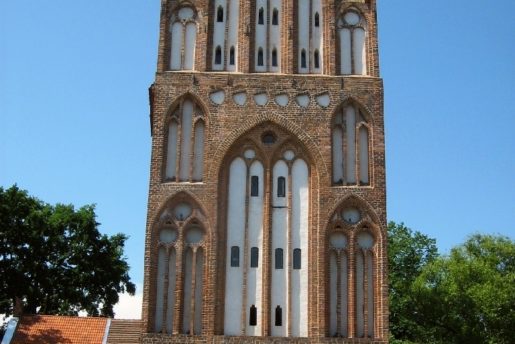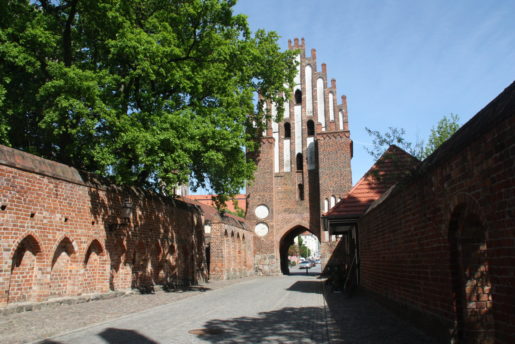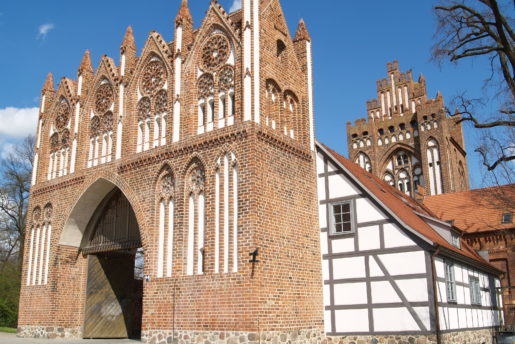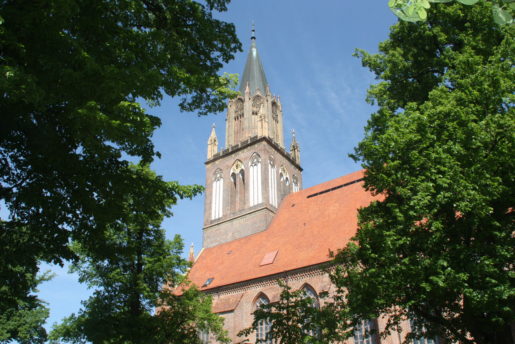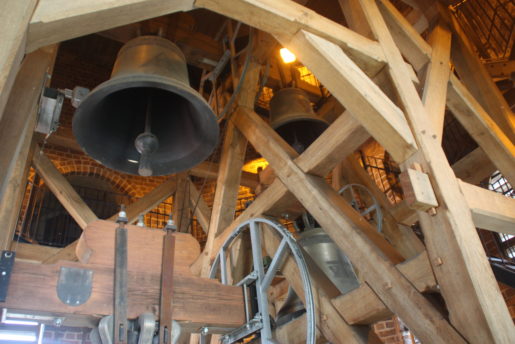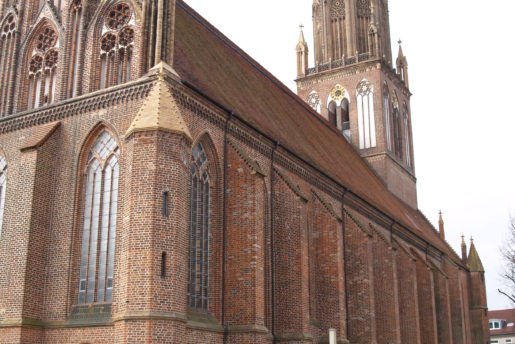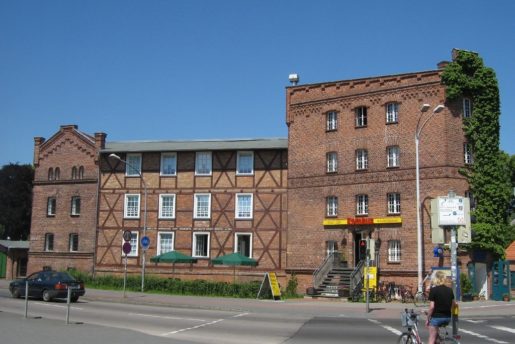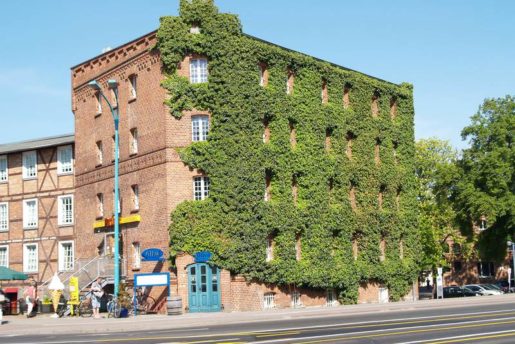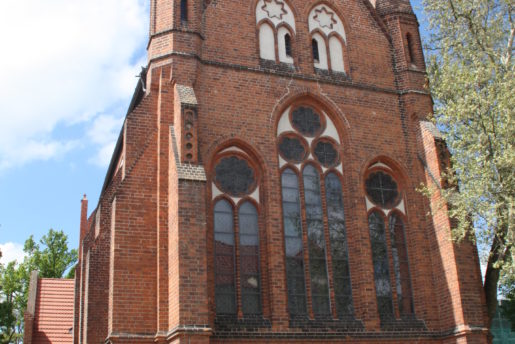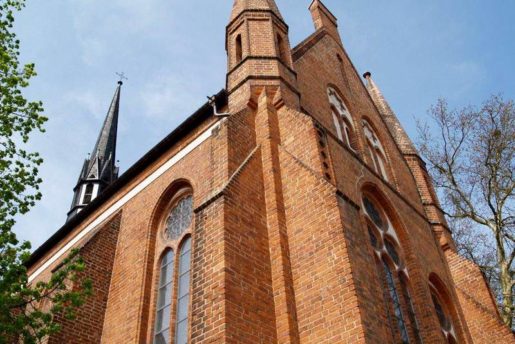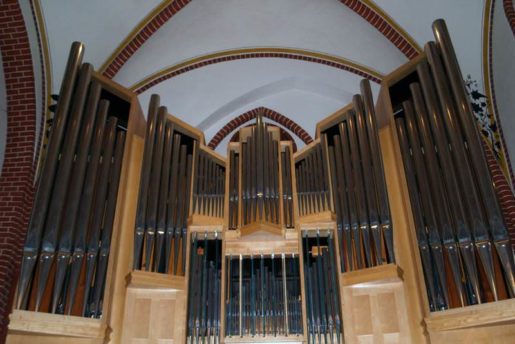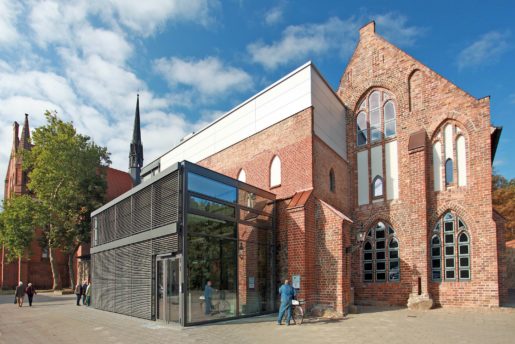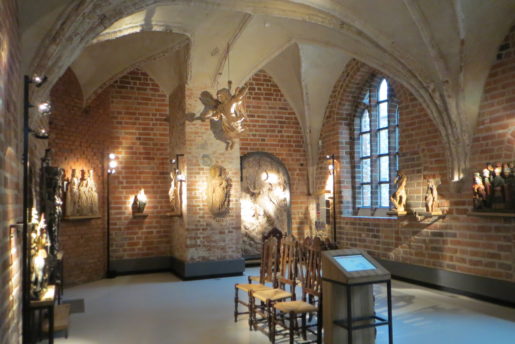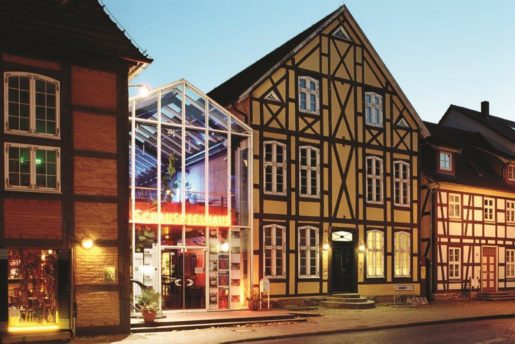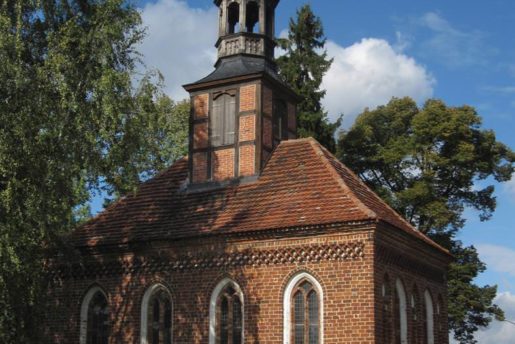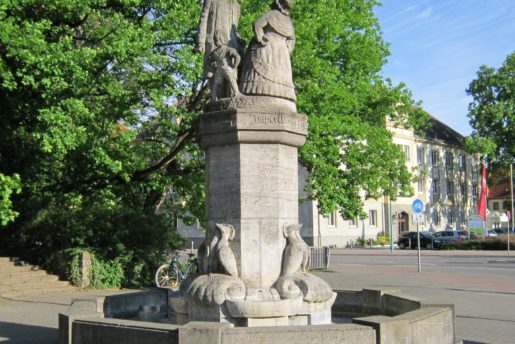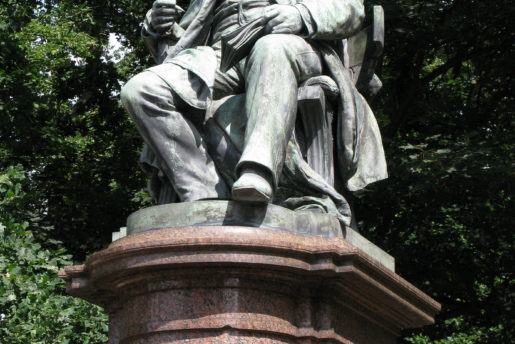Monuments and Sights You’ll be enchanted by the historical town wall with the gates and the Brick Gothic.
The city of Vier-Tore-Stadt-Neubrandenburg (Four Gates City), founded in 1248, invites you to an architectonical sightseeing tour through the old and the new Neubrandenburg!
The building and cultural history of the city is varied and worth to see. You’ll be enchanted by the historical town wall with the gates and the Brick Gothic. We are sure you will find many interesting facets on your tour.
Medieval fortifications
No doubt there is no second town, which has such a closed double ring rampart around the impressive medieval town wall like Neubrandenburg.
In every season this belt offers awesome nature experiences, surprising views through the green to the Wiekhäuser (small houses in the wall), the gates and towers and fascinating impressions of the defending abilities of a medieval town.
In spring and summer an opulent display of wild flowers is a feast for eye and heart. The golden autumn puts the rampart in many colors and the winter changes it in a sparkling white wonderland.
The rampart is composed of a double ring with three ditches, which were originally filled with water. The necessary and extensive work for this already happened in the Middle Ages. The inner rampart is 20 to 30 meters short of the town wall. Just as big is the space between the ramparts. Thereby the dimension of the complex is in parts up to 70 meters.
After the loss of its function as a protective building for the town the rampart belt had to serve as a wood reservoir, a meadow and even as a fish pond. Numerous medicinal plants announce in addition for a former use of the rampart as medicine chest and garden. Not till 1824 the rampart was arranged as a promenade.
Typical landmarks for the rampart are the oak trees. Some of them are more than 300 years old. And another botanical specialty is offered by the rampart: The “Seltsamer Lauch” (few-flowered leek). In spring this bulbous plant covers a wide area and exudes a aromatic flavor.
The Friedland Gate
Is the oldest, in its complexity the best preserved and with 88 meters length at the same time the largest gate area. Around 1300 the 20 meter high main gate was built on the town site. The outer gate on the field site was constructed in the middle of the 14 century.
Although the latter was built from the defensive point of view, one wanted to use decorations and ornaments. Both gates are connected with walls, which form the inner bailey. One century later the complex was completed with a three-floor and 8 meters high Zingel (half ring wall). This one was again connected with the outer gate and built a further inner bailey. The semicircle bastion defended the gate from large-calibre firearms like a backstop and served also as active defense as you can see at the existing arrow loops.
In the 70’s of the 20 century the whole complex war restored. The former custom house of the tax collector invites you now a comfortable café to stay. Furthermore you can find here the register office.
The Stargard Gate
Is the second oldest gate and builds the southern entry to the town. In the 14 century a 24 m high main gate (in 1310) and an 18 m high outer gate were built. Both gates were connected with a 40 meters long wall and in between you can find the custom house.
Especial the high embellished field side front of the outer gate is a symbol for the highlight of northern German Brick Gothic. Two mills in front of the gate complex (today there exists only the Lohmühle as a restaurant) were included in the fortification and built a protecting barbican.
Characteristic for the gate are the nine almost life-size figures of baked clay and plastered brick wall. They are called “Adorantinnen”. Over the years there were many hypotheses about these figures but the real meaning is still unknown.
The New Gate
As the youngest of the Four Gates of Neubrandenburg it was built after 1450. The deciding reason for the construction was that one wanted to relieve the main traffic route through the town.
Because it was decrepit, the outer gate was dismantled in 1852. For this reason only the main gate is preserved. The formerly uncompleted Zingel (half ring wall) was already destroyed in the Thirty Years’ War. Anyhow the New Gate fits worthily in the fortification.
In the town site gable niches you can also see eight life-size figures of baked clay, called “Adorantinnen”. In the contrary to the figures on The Stargard Gate these ones are different in size, have another arm position and the length of their robes varies. Furthermore the middle ninth figure is missing.
Today the New Gate is domicile of the Fritz Reuter Gesellschaft e.V. (society for the poet Fritz Reuter) and it is place of different literarily events.
The Treptow Gate
The Treptow Gate is the tallest and at the same time the most representative of the four gates. It documents evidently the affluence of the medieval town of Neubrandenburg and the pride of its citizens.
The town site’s main gate, constructed around 1400, has a height of nearly 32 meters and towers the field site outer gate above almost the double. This offered the possibility to observe and protect the area far beyond the outer gate. Already in 1873 the Treptow Gate was developed to a municipal museum, the oldest civil museum in Mecklenburg-Strelitz. Today the main gate accommodates the exhibitions for prehistory and protohistory of the Regional Museum Neubrandenburg.
The inner bailey is with its 34 to 10 meters smaller than the inner baileys of the other gates. In the 18 century a timbered house for the gate guard and the tax collector was built into the southern bailey wall. In 1856 beside the gate the first telegraph office of the town was built. The Four-Wheeled Mill in front of the gate, first mentioned in 1271, was connected with the Treptow Gate area through walls and other bulwarks.
St Mary’s Church - Concert Church
For more than seven centuries St Mary’s Church has presumed to be the greatest and most important historical building of Neubrandenburg. Its eastern gable counts to the most aesthetic creations of Brick Gothic in Northern Germany.
The work on this monumental building started with a boulder building block in the 13 century. Later the awarding authority decided in favor of a Brick Gothic building. In 1298 the church was consecrated by the bishop of Havelberg.
Over the centuries the church was victim of different town fires. Friedrich Wilhelm Buttel, student of Schinkel, reconstructed the building between 1832 and 1841. Some 100 years later St Mary’s Church was razed at the end of the Second World War. Since the middle of the 70’s till the 90’s there have been works for the reconstruction under the direction of the architect Josef Walter.
After a Europe-wide tender the Finnish architect Pekka Salminen convinced with his conception for the construction of St Mary’s Church as a concert hall. He integrated in the time-honored Brick Gothic cladding an ultra-modern concert hall. Salminen succeeded though a wonderful symbiosis of the old and the new. Numerous architecture awards appreciated the achievement of the Finn. The paper “Frankfurter Zeitung” found the following words: “Germany’s most remarkable reconstruction achievement since 1989.”
Germany’s most exciting Concert Church opened on 13 July 2011. Since then the excellent acoustic enthuses thousands of concertgoers. In 2007 five new bells and a new bell cage were installed in the tower of St. Mary’s Church (Concert Church). The festive consecration took place on 24 June 2007.
On 27 June 2007 the permanent exhibition “Routes of Brick Gothic – defense and decorative architecture in Neubrandenburg” in the tower was opened.
Vierrademühle - The Four-Wheeled Mill
You can source the history of the Neubrandenburg mills back to the 13 century. In front of the Treptow Gate, directly located on the main road 104, there is a multi-story brick building with a half-timbered outbuilding. This is the oldest flour mill of the town, the Four-Wheeled Mill. The first documentary mention is from 1271, which means short after the foundation of Neubrandenburg.
The son of the town founder’s son had built the mill, the simple line on the central block of this historical building reminds us: “Miller Bernhard, son of Herbord, founded this mill in 1287.” With the construction of the Four-Wheeled Mill happened a dam of the Lake Tollensesee for about one metre. Though the original effluent on the north end of the lake was blocked and the Oberbach was built as a 860 meter long canal. This water powered the four wooden mill-wheels which gave the mill its name. In the 18 century the mill developed to one of the greatest mills in Mecklenburg. Since 1925 it had run electrical. The Four-Wheeled Mill endured all troubles and twists of the modern times.
Today this history-charged building is open for the people of Neubrandenburg and their guests. An all-round discovery area invites you to stay. Gastronomical and cultural facilities found a home within these historical walls. Areas like services, habitation and education as well found place in this listed building.
St John’s Church & Franciscan Monastery
St John’s Church
Like St Mary’ Church the St John’s Church was built in conjunction with the Franciscan Monastery in the first years after the foundation of the town. It served in the first instance the friars for their prayers, which were hold together many times a day. After a fire one enlarged the church in the middle of the 14 century and built in addition the present nave. The Protestant Reformation in the 16 century influenced also the life in St John’s Church.
The Franciscan Monastery was closed and the space was used as a workhouse. After the Protestant Reformation the city took the patronage (sovereignty) for St John’s Church. The sermon moved in the center of the service. Thereof testifies the artful designed pulpit of lime stone from 1598. The rich ornamented baroque altar was constructed around 1730 and shows the religiousness in that time. The choir stalls placed in the sanctuary count for sure to the oldest samples from the Reformation period. As a sign of solidarity with St John’s Church the guilds donated around 1700 likewise worth seeing tin and brass candlesticks.
Because of wars and fires the church had to be reconstructed several times over the centuries. In autumn 1989 this church sent signals for the peaceful revolution in Neubrandenburg and the environment. Here took the prayers for peace place, which ended in the great demonstrations. Today the church invites you to services, for visiting and to pause. Especial the regular choir concerts and organ recitals are very popular.
Franciscan Monastery
Immediate after the town foundation in 1248 the Franciscan Order settled in Neubrandenburg. The monastic rules bound the friars to strict poverty. They saw their duties in the sermon as well as in nursing and poor relief. For the coverage of their living they were dependent on charity. For this reason they were also called mendicants. They wore a brown robe with a pointy hat and a white waist rope. According to the monastically life a self-contained four wings building on the northern outskirts was constructed.
Around 1250 as southern wing St John’s Church arose as a simple boulder church. Today from this original building only some parts of the north wall are preserved. In the beginning of the 14 century on the opposite site an additional nave (the current nave) was attached. In the 15 century the church’s east wing was attached by a 20 meter long sanctuary for the friars, which got a new use after the Protestant Reformation and which collapsed in the 19 century because of its wretched condition and a necessary street widening. Originally the sanctuary reached to the middle of the current road Stargarder Straße.
In the east wing of the Franciscan Monastery the friar’s dormitory and in the north wing the refectory (kitchen and dining room) were located. In the west wing the lay brothers were accommodated. The today best preserved part of the monastery is the refectory. After a fire in the beginning of the 17 century the east wing wasn’t reconstructed.
The Franciscan Monastery with the St John’s Church counts to the most impressive medieval buildings in Neubrandenburg’s city center. Hence and because of its meaningful history as well as thanks to the favorable position of the monastery the accommodation of the municipal museum is planned in the former refectory and the new constructed east wing. Because of this use the building will be made accessible to the public.
The Playhouse
Neubrandenburg has lost many of its most beautiful buildings in the last days of the Second World War. As if by a miracle the playhouse in the road Pfaffenstraße escaped. But theater had not been played for decades in this simple half-timbered building. Not till April 1994, after 100 years of misuse, the lights switched on again in the oldest preserved theater building of Mecklenburg.
In 1775 the sovereign of Mecklenburg-Strelitz, Duke Adolf Friedrich IV., established his summer residence in Neubrandenburg. In this connection he had built amongst others the ducal playhouse in the Pfaffenstraße around 1780.
Adolf Friedrich IV. promoted the court theater and that led to a first flowering. But with the princely generosity also the burden of debts increased seriously. As “Dörchläuchting” died in 1794, his brother Duke Carl assumed the government affairs. Because of the necessary cuts plan in the holding of the court he closed the court theater. For the playhouse followed some years with a changeful history: After the reconstruction in 1825 by the Neustrelitz government building officer Friedrich Wilhelm Buttel the Neustrelitz court theater and various touring companies made again some shows.
During the Revolution in 1848/49 in the playhouse were hold moots and in the German-French War it served as a military hospital. Doctor Mercker bought the house in 1894 and established an institution for motion cures. Extensive reconstructions followed and the house got an oriel. During the Second World War it was used again as a military hospital but after 1945 the playhouse was left to decay. In the meantime it served as a vulcanising and motorcycle workshop and as a communal hall.
Since its reconstruction in 1994 the playhouse has glistened in its new splendor. What looks like an old jewel case from the outside is a cutting-edge theater location. The latest stage and auditorium technologies were installed and place for 180 people was created.
With a live connection Stockholm-Berlin on 19 May 2008, the Nordic Route of “European Route of Historical Theaters” was opened. Parts of this project are historical theaters in Sweden, Norway and Denmark. The Nordic Route is attached to the already existing German Route, to which belongs the playhouse. Both Routes are part of the new “European Route of Historical Theaters” and offer together a wide section of all kinds of theaters and at the same time the best of the 18 and 19 century.
On the Nordic Route you can see prior theaters from the 19 century while the German Route delivers insight into the theaters from the 18 century. It connects 12 theater places and runs through Mecklenburg, Brandenburg, Saxony-Anhalt, Thuringia, Bavaria, Baden-Württemberg, Hessen and Rhineland-Palatinate to Koblenz. With the in 1794 opened Neubrandenburg playhouse the oldest theater in Mecklenburg-Western Pomerania is part of the German Route.
St George’s Chapel
In the Middle Ages there existed three chapels just outside the town’s gates. All of these were located on the access roads. On the former road Strelitzer Landstraße was the Gertrude chapel and in front of the New Gate was the Catherine chapel. Especially after the close of the gates they gave room and board for travelers and pilgrims. During the siege and escalade of Neubrandenburg in 1631 both chapels were destroyed by Tilly.
Only St George’s chapel (which is named after the patron of the crusaders) survived the troubles of the time. The holy George, dragon slayer and guardian of the ill and the poor, had a high reputation in the time of the crusaders. The small early Gothic brick stone chapel outside the Treptow Gate was first mentioned documentary in 1308. In the contrary to the both first mentioned St George’s chapel was a hospital chapel. Around the chapel was situated a small place with a cemetery. In the chapel and the directly surrounding neighborhood with leprosy returning pilgrims and later the plague patients found accommodation and care.
The sacred care of the here residing ill people was taken by the friars of the nearby Premonstratensian monastery. A solar clock (a small circle in the building brick) on the chapel’s west side, right of the entrance in at eye level, reminds this very day of the keeping of particular prayer sessions. Thereto the preacher put a thin stick in the middle of the circle and could define the time with the help of the shadow. As of the 18 century the surrounding houses of the church were used as hospital for the elder town citizens.
Today they are hotel and restaurant. In recent years the chapel was reconstructed several times but because of its bad condition the building has been closed for several years. In 1994, after conclusion of the last reconstruction, St George’s chapel was opened again to the public. Today for example service, smaller concerts and discussions take place in this building. Sacral arts of this chapel, like the gothic retable, which reminds of the friar’s services, can be visited in St John’s Church and in the Regional museum (exhibition of city history).
Fritz Reuter Monument & Mudder Schulten Fountain
Not far from the station a patriarchal gentleman looks from his two meter high granite socle on the goings-on around him. Fritz Reuter lived from 1856 to 1863 in Neubrandenburg. The Low-German poet was born in Stavenhagen and felt a strong bond to “his Neubrandenburg” like to no other town. “His people of Neubrandenburg” thanked him by a donation campaign which delivered 32000 mark. With this money they could build the monument in 1893.
Fritz Reuter was a teacher and had his literary most productive years here in Neubrandenburg. He wrote for example “Kein Hüsung”, his perhaps socially critical work.
Vis-à-vis the Fritz Reuter monument you can find the Mudder Schulten Fountain. The sculptor Wilhelm Jäger created in 1923 the group of figures out of a 250 hundredweight coquina block.
On the fountain you can see a scene of Fritz Reuter’s humoresque “Dörchläuchting”.
The baker’s wife Mudder Schulten called on Dörchläuchting (Adolf Friedrich IV., Duke of Mecklenburg-Strelitz) to pay the bill for delivered bakery products. Fritz Reuter described this (fictitious) story in his novel “Dörchläuchting”.
Memorial sites in Neubrandenburg
Memorial sites of the local history til 1918
1 Plaque for the victims of the Thirty Year’s War
The Friedland Gate area – Plaque for the victims of General Tilly’s siege in 1631
2 Tomb for the victims of the First World War
New cemetery- Rebury of the soldiers graves after 1922 and creation of a worthy memorial site. More information
3 Stone for the dead soldiers of the First World War
Northwest in front of the Jahn-Stadion – In memoriam of dead Neubrandenburg gymnasts
4 Stone for four soldiers died in the First World War
Bergstraße – area of the gun club – in memoriam of the Neubrandenburg gun craft
Memorial sites of the Weimar Republic 1918–1933
5 Plaque for Hans Arno Eckelmann
- A. Eckelmann was shot in 1924 by a police patrol and died three days later. More information
6 Memorial „Kleiner Trompeter“
Southeast behind the new cemetery – The Monument remembers of Fritz Weineck, trumpeter in the band of Roter Frontkämpferverbund, who was killed by the police in 1925. More information
Memorial sites for the victims of National Socialism 1933–1945
7 Place of the synagogue
Poststraße – Place of the former synagogue, which was destroyed in Pogrom night (night of broken glass) of 9. /10. November 1938. More information
8 Isidor-Heine-plaque
Friedrich-Engels-Ring 29 – ce of the former house of Isidor Heine, the last abbot of the Jewish fold in Neubrandenburg. More information
9 Area of soldiers’ tombs of the Second World War
New cemetery- More information
10 Memorial site Fünfeichen
Fünfeichen – Tombs for about 500 dead of the Allies and mass graves for more than 6.000 dead Soviet prisoners of War of main camp II A and officer’s camp II E 1939–1945
11 Hospital-Cemetery
Area of the tank barracks, Weg am Hang – place of burial for 53 dead soldiers in the Second World War. More information
12 Cemetery for the dead of typhus
Tannenkrug, Am Gartenbau – Place for about 200 victims of the typhus-epidemic after the end of the Second World War. More information
13 Memorial for the dead soldiers of the Red Army
New cemetery – Tombs for 261 dead soldiers of the Red Army. More information
14 Military cemetery – victims of the Second World War
Weitin – Place for three German soldiers in single graves and for 13 dead soldiers in mass graves . More information
15 Women-Memorial
Mühlendamm, south of the new cemetery – place for 100 women from the external camp of concentration camp Ravensbrück. More Information
16 Plaque for the haunted of the Nazi regime (VVN)
Wall near The Stargard Gate – Stone for all victims of the National Socialism . More information
17 Memorial site “Die Unbeugsamen”
South of the new cemetery – in memoriam of the victims of War and displacement after the end of the Second World War . More information
18 Memorial stone for the displaced
Exit Große Wollweberstraße / rampart – in memoriam of the victims of War and displacement after the end of the Second World War . More information
Memorial sites for the victims in the time from 1945 to 1948
19 Memorial site Fünfeichen
With the begin of the Second World War a prison of war was established in Fünfeichen. After the end of the war the Red Army organized the return of the former prisoners of war, the concentration camp prisoners and the forced workers. More information
Memorial sites after 1989
20 Memorial Plaque autumn 1989
Evangelic church St. John – In memoriam of the occurrence which led to the fall of the GDR-system in autumn 1989. More information
Stolpersteine (small stones in the street in memoriam of dead Jewish people)
21 Ziegelbergstraße (Behind the „Hotels am Ring“)
22 Neutorstraße 41
23 Friedrich-Engels-Ring 29
Historical educational trails
A Educational trail „The GDR’s state security headquarters on Lindenberg“
B Educational trail „„Forced labour in the northern town of Neubrandenburg“
C Educational trail „Jewish live in Neubrandenburg“
Touristinfo Neubrandenburg
- accommodation office
- counselling and sale of souvenirs
- placing of guided journeys and city tours
- information and brochures about the city and environment
- information and offers for an accessible holiday
- maps for cycling and hiking
- ticketing and many others
Book your journey and your personal adventures with us. We will be happy to advice you!
Opening Times
Monday to Friday: 10:00 – 19:00 Uhr
Saturday: 10:00 – 16:00 Uhr
Please note our special opening times during city-centre events
Contact
Touristinfo Neubrandenburg
Marktplatz 1
17033 Neubrandenburg
Tel.: 0395 55 95127
E-Mail: touristinfo@neubrandenburg.de
City of Four Gates on Lake Tollensesee
www.neubrandenburg-touristinfo.de



